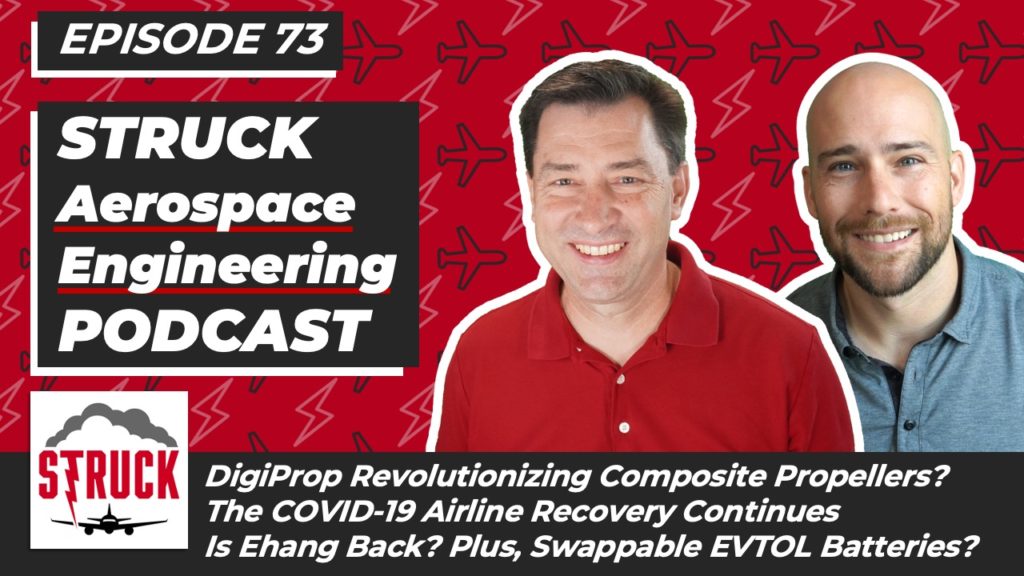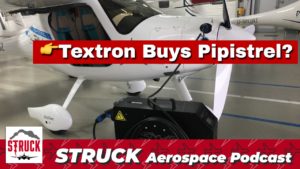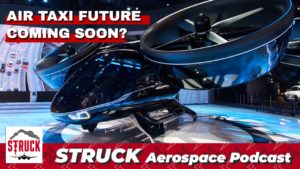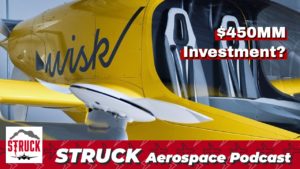The DigiProp program is aiming to bring complex composite propeller designs to life easier and faster – is it working? Plus, we talk about the COVID recovery and a recent report that $201 billion was lost due to the virus’ impact on airlines. Lastly, Ehang showed off its new VT-30 EVTOL recently – where is Ehang going? And, AirBus and Honda are now off and running – will their designs fit a different niche than Joby, Volocopter and others?
Learn more about Weather Guard StrikeTape segmented lightning diverters and aircraft lightning protection consulting services. Follow the show on YouTube, Twitter, Linkedin and visit us on the web. Have a question we can answer on the show? Email us!
Podcast: Play in new window | Download
TRANSCRIPT: Ehang Shows VT-30; Will EVTOLS Ever Have Swappable Batteries?
this episode is brought to you by weatherguard lightning tech at weatherguard we support design engineers and make lightning protection easy you’re listening to the struck podcast i’m Dan Blewett i’m Allen Hall and here on struck we talk about everything aviation aerospace engineering and lightning protection
All right welcome back to the struck airspace engineering podcast i’m your co-host Dan blewett on today’s show we’ll talk a little bit about uh southwest and some other coveted vaccination rules that airlines are starting to enforce their employees and we’ll talk a little bit about the recovery still kind of an update for the fall season here about uh covet and where the airlines are going we’re going to talk a little bit about digiprop which is a program looking at the use of thermoplastics and braiding and some other interesting techniques for making propellers and we’ve got a bunch of evtol news we’ll chat through today alakai and their sky hydrogen ev2l is looking for investment we’ll talk about their design and some of the challenges there honda’s also throwing their hat into the ring developing a hybrid electric evtol and we’ve also got some announcements from ehang on their vt30 some clarity on airbus as they explain explain their design behind the city airbus and lastly uh just some interesting um info about battery swaps and whether this might be something that could come to aviation or maybe it won’t work we’ll see um alan let’s start with southwest so the latest airline to uh mandate their staff all 56 000 employees to get vaccinated by december 8th and of course this comes at the heel of a of a article by al jazeera that says the global airline industry has seen a 200 billion dollars 201 billion dollar uh loss due to cove at 19. so is this just the latest airline just trying to protect themselves as much as they can obviously hiring and the workforce is a very difficult it’s a very difficult time to find employees and to keep everyone up and running i mean how do you view is this like the natural progression here that all these airlines are doing this well united did it a little while ago and now southwest is into the same position i think uh i think american and delta are in the same boat at the moment uh i think you have a really hard time with this we’re already seeing the same sort of prescriptive uh you either have a vax vaccine or you or you’re fired and we don’t provide severance which is a nice little twist uh that is not working well in my area right now and new york state has had a big purge in a sense of where they’re just firing all the health care workers that refuse vaccinations and that includes all staff it’s not just nurses and doctors it’s everybody that works around the hospital food service clean uh janitorial people it’s a big deal uh and i’m not sure in in the sort of uh environmental today that it this is a good long-term solution for the airlines i know at the short term it raises some pr it makes people a little more comfortable to go fly i think but do i really care if the line mechanic has a vaccination or not or has previously had covet i i don’t think i care as a part of the flying public it seems like more of a personal decision so when these companies are stepping in into sort of health care matters in america it’s going to be a problem there’s going to be a 10 to 20 percent of the population that will not participate in that regardless of what goes down and at a time when the airlines are struggling i’m not sure you need any laying off employees or letting basically firing employees i’m not sure that’s a smart move i think there’s other ways you could have gone about it but here we are do you think that do you think this is going to get mandated beyond airlines right now do you think this is just sort of going to be a universal thing uh i’m not sure i mean part of this announcement from southwest is that they’re a federal contractor right so the us government mandate therefore applies to them and that’s the same boat for american a couple other airlines um you know delta is also a federal contractor but they have not made this announcement yet who knows if they will it seems like it’s probably coming here and of course united united mandated vaccines for their staff and it says 96 have given proof of inoculation so um trying to meet that deadline which was a week ago so it seems like it’s working number one um yeah i don’t know i mean i don’t think mandating vaccines is the right move but then again it seems like we’re going to have to live with covid forever like it’s just so i mean we live with the flu forever COVID’s more contagious than that it seems like it’s never going to go away so for companies that want to get back to normal um especially if they’re on the hook for some of those health care costs which um which airline was was talking about that was that united who said that you know if you don’t want to get vaccinated we don’t want to pay for i’m not sure if it was them or not i can’t remember but yeah they don’t want to pay for you know that that expense if you don’t want to it’s going to be more expensive to get your health care if you don’t want to get vaccinated and i think that’s it’s interesting um i don’t really have a stance on it either way at the moment but you know people have a right to control their own destiny but again when it comes when it also affects a company that needs to move forward you know yeah it it’s it’s complex complex so but you know it’s complicated yeah yeah because yeah you have right to do what you want but our company has the right to do what they feel is best for the company as well and if those two things don’t align then maybe you have to find another company to work for you know that’s i don’t know no one has a right to work for any given company right you don’t have a right to work for southwest you choose to work with southwest and southwest chooses to employ you and and play by the rules there too so it’s you know with private companies it’s hard to sorry to know but yeah i think people do have to kind of play by their rules they they they they well short term right i think uh it’s all depends on how rigorous the validation is i think a lot of people in the united states have already had cove and i think there’s a really good argument to make about if you already have had kova do you need to have the vaccination and also a large part of southwest is in texas in terms of operations and i’m i’m when when you hear anything when you hear any vaccination number that’s above 75 80 percent you really wonder if that is a true true accurate number because the vaccination numbers around the world are somewhere in the 75 to 80 percent then it turned and it kind of tops out so i i’d be surprised if any airline had really 95 plus percent um vaccination status i wonder if some of that has been doctored or not but hey that’s the world we live in right i think there’s going to be some big time drawbacks when the next union negotiation happens because it’s going to come up and i think i think the unions have will have enough power to drive that out of the negotiations like you can’t you can’t start firing union workers because they’re not vaccinated with something that you prescribe because i think from the union’s perspective where does it stop right i i think you know there’s a slippery slope argument going on right now and that’s a valid argument to have uh but workers are not without rights and particularly in the airline industry the units are relatively strong so when you when the next go around happens i’m curious to see if this starts a little bit of a fight and it probably will but it looks like global capacity for airlines is about 70 of 2019 levels so that’s encouraging that that rebound has happened it was around that level back in july and then took a dive back uh between august and and september when you know the outbreak started to accelerate again but it’s like we’re getting there but 70 is pretty low it’s not like that’s a high amount but it’s obviously a lot better than what it was in 2020 which was nothing essentially so right yeah so the rebound is the rebound is rebounding i guess we can put it that way and we’ll see how the vaccination stuff continues to impact that but i mean that might make people more apt to go fly when they know all the employees on you know walk in the aisles have been vaccinated and most people on a flight would have been vaccinated as well so maybe that gets confidence back up where people get out there we’ll see um so moving on some interesting engineering stuff so on this digiprop project where they’re looking at new ways to develop composite propeller blades specifically for turboprop aircraft so obviously these are complex shapes they have a lot of contours they’re difficult what are some of the things that this digi this digital propulsion um project is is trying to solve well when you have to lay up a prop there’s a couple of ways to do it composites wise there’s been in some cases a lot of it i think is still hand layup on the construction which then adds a lot of cost and the complexities of the shape uh are only getting more complicated as we go along right it’s not like the 1950s you got basically one sort of prop design now because we have computational fluid dynamics and the computation power we can make really efficient propellers that maximize thrust or be noise quieting or whatever you want to do so you’re getting some really unique shapes and composites wise that can be difficult to make and and what this project is doing in conjunction with it looks like ge aviation is there basically making a tool and then uh winding carbon fiber over top of that tool much like you would over braid a wire harness i’m gonna put this in electrical world for a minute so if you have a wire harness you actually you’re trying to shield it from lightning or or rocks and dirt and debris and stuff you actually can weave a a sleeve over top of it and that’s what this propeller is relatively doing they’re just kind of weaving the the com composite structure onto this tool you can define where the strength is where the strength isn’t you can really minimize the weight impact you can put fiber exactly where you want it which is fantastic and but the second piece is is they’re using thermoplastics and so instead of using a standard uh thermal set resin prepreg kind of thing they’re using um thermoplastics to bind to bind this all together and the benefit of thermoplastics is just they’re really just tough you know it’s just a toughened system uh they’re immune to most chemicals they just are just a real durable system the thing about thermoplastics though is that they’re expensive and so you want to try to minimize waste in that situation which this sort of weaving process will do so you just have a lot less waste a lot less expense even though using a much more expensive material you’re trying to minimize the overall cost of a propeller so there’s some interesting technology here dan and i think this technology has been kind of used as sort of sock sleeve methods been used for some aircraft structures not a lot of them there’s not a lot of opportunity to do that but i think we’re going to see it more and more and the thermoplastic piece which is the interesting part uh not a lot of thermal plastics using airplanes today because the cost issue so we got to find a way to lower the cost to use thermoplastics because there’s such great materials and they are recyclable which is that other piece right so the recyclable piece drives a lot is going to be driving a lot of designs particularly in europe and eventually in the united states that thermoplastics have been sitting around for 30 years plus on the sidelines like hey we’re recyclable and everybody’s been well you’re more expensive so it doesn’t matter we’re going to go use the most inexpensive thermal set but those rules are changing and that world is evolving and thermoplastics are coming into their own so i expect to see more thermoplastics used and it’s good that ge aviation is actually participating in this because they can provide the funding some of the engineering resources to to bring it to reality which is good so you know as this as the different tapes are sort of braided around this mandrel in the center does that mean that the final the final propeller is hollow inside yeah yeah or they can or they could fill it um there there are different techniques to sort of make a shell and then uh put some structure inside of it too but again it adds labor so if you can make this thing stiff but light because it’s mostly hollow or is hollow even better right all right so let’s move on to our evtol segment today so a bunch of different designs to talk through number one uh alakai which is spelled a l a k a apostrophe i they have their sky hydrogen evtol which looks more like a bus shaped like it’s clearly meant for multiple passengers maybe like six or eight and uh but they’re looking for this to be a hydrogen powered aircraft so alan what are some of the differences before we talk about the actual design of it what are some of the differences pros and cons of using hydrogen for an evtol versus electricity well it’s weighted energy density and that’s that’s that’s it that hydrogen is essentially doesn’t have any mass you’re going to have some storage tanks to hold it but unlike lithium-ion batteries it’s just a lot less weight for the energy density so you have a lot more energy density you’re kind of approaching aviation fuel in a sense so the it that’s the advantageous part of this is that you had a couple of hydrogen tanks which you can do pretty inexpensively and lightweight because you make them out of carbon fiber and you can have a lot of energy storage on the aircraft which is the problem that electric battery-powered aircraft are having is like where do i stuff all these batteries to get to do my mission hydrogen will not have that problem and so i mean that seems like a pretty great pro so why don’t more companies want to tackle hydrogen right now it has to do with ability to refuel it mostly that uh if there’s electricity everywhere there’s not hydrogen everywhere now if you’re having dedicated sites where you’re mostly flying to then hydrogen will most likely be available at those airports or those landing spots but there’s electricity is everywhere and so you can in theory land almost anywhere in a battery powered electric aircraft and and uh refuel quote unquote refuel you really can’t do that with hydrogen today and that i think that’s a big concern on the automotive side and on the aircraft side is like where are these refueling stations and how is this going to work because technology wise hydrogen is well understood you have a hydrogen you have a fuel cell which basically takes a hydrogen and starts making electricity in the aircraft which is then is used to spin a bunch of motors which provide the lift conceptually that’s it it’s not particularly complicated not a lot of moving parts here it’s just where do i refuel it that’s that’s that’s the problem today and so it looks like they’re looking for funding um they need more investment uh which obviously every aircraft company does um i mean our investor is going to be reticent to take something like this on or i mean they’re pretty comfortable with the electric sector obviously like you know a lot of companies have gone public uh with their electric evtol models um i mean what would be the investor hang up here i think the hydrogen is is the one right now because there’s so much momentum on uh all the specs around like joby and archer on these electric aircraft that have wings and sky doesn’t have wings it’s more like a drone so it looks like a basically an suv with a couple propellers on top that provide lift so it it’s a much smaller thing so from the investment standpoint if you’re looking to do those uber type runs or those lift type runs where you’re getting from my driveway to the local pizza shop you can’t do that in a joby it’s just a much bigger aircraft because it has wings and those wings are big it’s providing lift right that’s you have to do that with a battery-powered aircraft the hydrogen-powered aircraft you have a lot of extra energy storage so you can actually make like a helicopter-ish aircraft so i could then with sky go from my driveway to the pizza place in a sense because i have just a much smaller footprint and i can i can land in a lot tighter places which makes a lot more sense to me so if i’m uber or a company like lyft and i want to get in the aircraft market i want to be able to land in places that are not airports all the time and the size of the vehicle is going to have something to do with the number of landing spots they have so there’s a really odd dynamic that’s happening right now and i i’m not sure why sky’s not getting a lot more looky uh people just looking in the windows checking them out kicking the tires a little bit because i think they’re going to be able to serve in metropolitan areas like boston new york uh philadelphia baltimore washington dc up and down the northeast corridor i think they’ll be able to serve a lot more places with the vehicle they’ve designed than an archer would gotcha well we’ll keep an eye on them but yeah it seems interesting they’re doing something that’s definitely outside the typical box at the moment um so yeah we’ll see what continues to come of that uh honda which i know you’re a champion of honda jet you know they’re pretty um they’re sharp looking and they’re very fuel efficient honda’s on great work with their jet side uh looks like they’re now revealing new plans uh for an evtol sort of throw their hat in the ring which again them and airbus have done this recently so on september 30th they announced that the honda evt well uh which will be a hybrid week a gas turbine um hybrid powered unit but what do you think of this design it’s got some ducted i guess are those more rudders on the back then or is that propeller i mean what what do you what do you see here at the design i think it’s still prototype design it’s still in that conceptual stage from what i can tell now i haven’t talked to the to the people i know down at honda uh because i’m sure this is super top top secret they wouldn’t tell me anyway but the engineers at honda are really smart and aerodynamically they know what they’re talking about uh i i think what honda is doing and some of these others are doing is they’re looking at what the real usage of the aircraft will be because when they announced this they had a honda had a little video that popped out uh describing the typical day of this ev tall which was i’m in boston and i have a a meeting in manhattan and so i i get up i have breakfast i hop in this shuttle and i make that i think it’s about 200 mile-ish kind of flight uh i fly down to new york i have my meeting and i’m back home by supper that’s totally different than sort of the joby uber archer pickum uh approach at the moment which are a lot of 30 40 flights short flights a day within a metropolitan area so honda’s thinking more of a vehicle that’s like an entry vehicle to their jets right so the jets can go several hundred several thousand miles on a tank of fuel uh this aircraft is is much more sort of city to city jumps major metropolitan area to metropolitan area houston probably to dallas uh miami to tampa kind of thing there’s a really interesting nation there and i would be hard to say that honda doesn’t mess around like they someone has thought about what those journeys look like and what how we design a vehicle to fit into that mode and and meanwhile and dan have you looked at the airbus design which is sort of a competing design to the to the honda have you seen how airbus is also talking about sort of shorter flights and a simpler aircraft than some of these others that are much more complicated it’s there’s just so many engineering things going on here right now that are all competing you kind of wonder spec wise investment wise where the money is uh because it feels like we got a billion dollars or a couple couple billion dollars investment money sitting in california at the moment and yet uh california hasn’t been a real boon for aircraft in 30 40 years it’s just odd now uh don’t you feel it like honda’s in uh oh airbus is in uh-oh bell’s gonna be in uh oh what are you gonna do uh you’re competing against companies that just have the wherewithal to do it yeah and like we’ve mentioned that that seems like a it seems like entering the game a little bit later must probably probably pay it off because let other people kind of duke it out and see what’s going on see what markets others because at this point you figured out what what market other competitors are probably going after and then you could say hey there’s a hole there’s a there’s a niche here that we could fill can we design something that will hit this market and let them they can do their thing we’ll just do this other thing um yeah i feel like that makes sense from a business case standpoint for sure yeah i think someone’s got to do the non-uber part of this where is it and i think airbus and honda are stepping into that mode already which is really fascinating because the next three or four years are going to be a lot of aircraft development well like you said you know the the lighter aircraft are more dangerous like right they crash um pilot error and so if someone’s got the money and wants to sort of puddle jump and get to work or go here go there go see the the grandkids or whatever um you know they could have their million dollar electric vertical takeoff landing vehicle that’s probably gonna be a lot safer a lot more obviously high-tech and like you said you could lose a propeller and still be fine and uh yeah mm-hmm so it might make might make sense where yeah the husband or husband or wife you know you know whoever whoever doesn’t want it they might be more okay with it you know not just the wife anymore oh the wife will let me get this but like yeah the husband or the wife they don’t care they don’t think i’m going to die in this new high-tech thing so i can get it i can get a evtol but i can’t get a you know a light sport or something like that so that could be like i said could be could be a different market for it than some of the other uses so speaking of which uh ehang they’re longer range and they have a couple they’ve two models their longer range VT-30 um is has been unveiled yeah so ehang had some tough press earlier in the year being accused sort of of not really having much going sort of falsifying some documents and some information but they still seem to have been they’re chugging along and they’ve announced more about this vt30 which definitely has a a unique design allen what do you think of their their longer range passenger vehicle here well i i guess it may be feeling an another niche in china i don’t see this aircraft leaving china for a while multiple years unless you know the like in japan they decide they’re just going to let it in uh without having all the certification things we would typically do for any sort of aircraft nihing seems to be creating aircraft without necessarily meeting all the international standards on a lot of different areas i think so there’s a there’s a growing concern about it um you know from an investment standpoint i think there’s still questions about where they’re going and can they generate the kind of revenue i think it all depends on what the government allows them to do honestly if the government in china decides to look the other way and let these aircraft be traded and sold and they can start selling flights on them and not have them go through the hundreds of millions of dollars it takes to quote unquote certify an aircraft in the united states or europe yeah they can make some money if they get stuck into doing the same sort of rigorous flight testing and all the safety evaluation and all the other things that come along with aircraft development it’s hard dan there’s a lot of aircraft companies start up and most of them fail because the cost and the complexities are so high to get anything real and to make money on it um it’s a huge impediment and that’s and that’s why you see companies like joby and archer and the rest of them are not necessarily aircraft companies they are ride share companies because i think the aircraft sales by themselves won’t do it but somehow eaning thinks they’re going to be able to to make money on sales and see well and so last week we talked about airbus and you expressed you know we both expressed that we weren’t exactly sure what their target was and what their goal was and um what so and so what their design was sort of built around but they’ve um kind of explained a little bit more this this week so alan what did you learn about about airbus and and some of what they’re going for with their their new city airbus design well dan it looks like they’re just trying to keep it simple and that’s essentially it don’t try to push too hard which then puts the safety of the aircraft at risk control how far it would normally fly i think a lot of european cities are closer to one another than in the united states that makes a little bit easier and then they probably looked at what the roots would be how long they would be flying and and where the sweet spot is so they’re not pushing the envelope so to speak and their airbus does have designed airplanes that that’s not obvious already and they’ve been doing a lot of they obviously have airbus helicopters they know how to do helicopters uh i i think they’ve been working on a number of designs over the years and they’ve flown some of them and they put out pressure leases but they really haven’t gone anywhere so it seems like now airbus is basically saying hey let’s keep this thing simple let’s don’t make it overly expensive let’s just make it super reliable and do one sort of task extremely well and that’s a great product i think do what you do the best you can in the world and no one else can it’s going to be really to compete with that i think particularly if they slap on the airbus name on the side of it it has a lot of weight in terms of sales because dan it’s just like buying a new car i know there’s a couple of electric vehicle manufacturers are starting up the united states uh what’s there’s a couple in ohio one in ohio one in illinois uh Rivian is that is that one of them Rivian. Rivian’s one of them have you have you heard of that rivian yeah yeah so if i’m it’s a cool kind of suv electric suv sort of thing something that tesla doesn’t make my concern with those is that they could be a great vehicle same thing uh with uh you know a non-brand name like a like an archer sort of thing that doesn’t have any doesn’t have any infrastructure there there’s no service centers there’s no there’s nobody there to support it right so even though there may be a cool automobile out there or a cool aircraft if i can’t get it fixed or get parts for it it’s pretty much doesn’t matter to me i’m not gonna purchase it airbus carries that weight because they have all that infrastructure already pre-built so there’s a huge advantage for airbus to enter that marketplace and be an immediate dominant leader just because they have the service dealers they have the infrastructure they have all the people in place to answer the phone and some of the other aircraft companies don’t right yet so that that’s what i think dana you you kind of see that too that airbus really can carry some weight in the marketplace yeah i mean i think if you’re especially you know if you’re one of these airlines that might like buy from them or partner with them i think you’re pretty comfortable partnering with airbus it’s a big name you know you’re gonna have like you said a lot of support and if something goes wrong all that stuff that they’re going to be there so yeah i i i agree i get that so they’re going to have some clout for sure as all as these bigger players enter the market yeah and one of which could be it’s interesting concept um so there’s an interesting uh video this is from general aviation news um of a person swapping out batteries of a like a more like a like a vespa and uh and so you know you see this person pull over and pull this pretty large battery out of you know these two large batteries that are underneath the seat and they put them in this big bank that has probably 40 of them right there just push these big batteries which are kind of like the size of a maybe like a two quart milk container and you know push a couple of buttons and then it sort of says hey you can take these two pulls them out puts them in the thing and then goes which is really cool they don’t have those in the us the scooter market like the smaller like actual like the kick scooter kind um they are now all switching to swappable batteries so people aren’t rounding up electric scooters anymore in their pickup truck or their box truck at night taking them home to charge them then putting them back out on the market or on the streets which is what that’s what the model was up all up until now a couple companies now have swappable batteries so now people just come around yank the batteries put in a fresh one and they’re on their way which makes so much more sense logistically and it just allows the scooters to stay out there so uh is this something the big question here is is this something that could come to the evtl market in the future or is this the size and the complexity of these batteries the way they’re engineered into the aircraft is that going to be a limitation where it’s maybe not going to be realistic well that’s a really good question dan because i you have seen this in other industries like when chevrolet started with the volt and some of the predecessors to it there was always talk about dropping out the battery pack on a car and putting a new battery pack in it as a refueling station which is a battery swap out and that that hasn’t come to fruition because tesla’s never needed it i guess that because they can charge the battery so fast to get you back on the road on an airplane though it’s going to use a lot more energy right there’s a there’s a lot more energy usage i think even though they talk about it takes less energy than driving a tesla um uh there’s a there’s a lot bigger there’s a pretty good sized battery pack in there and airplanes tend to want to have short turnaround times they kind of need to uh i think pipistrel’s design has a removable battery stack in the front of it so you can actually pull some batteries out puts them in uh by aerospace is designed out in colorado i think that’s more of a quick charge situation you can charge the batteries fast enough but i think beta’s design up in vermont up here i think the way they design that battery pack in a sense it’s like all one place sort of towards the middle of the aircraft where you could in theory pull some batteries out put some new batteries in which may be advantageous for the customer ups like if if you need a quick turnaround you just you could probably swap batteries it may be a thing to go do so i think the concept is there is whether you could really implement it or not like where do you have all these batteries stack drawn all over the place well if i’m ups maybe i do maybe that’s what i do it’s because i’m ups and i can manage that whereas if i was just a regular owner and i landed in you know sort of nowhere massachusetts the chances of me having another battery pack to swap is essentially zero right so i think i think the technology makes sense though don’t you i think it all depends on where we’re going right as a country as as a country or as a world on are we going to go electric or not and if we are is that part of the mix it’s this battery swap out thing and what what standard do we make it to think of it this way dan you know the big the big controversy in europe well one of the controversies in europe because there’s multiple at the same time as like the iphone charger plug right that that they actually have i’ve seen commercials in the i think it’s from the uk or european union at least that are fighting for a common standard so that they don’t have to replace any of the charges they’ve they passed it yeah just recently which makes sense because there’s yeah we’re charging them all the same way like they’re all getting charged why do we have four different connectors and then this is the thing with laptops too they all still have proprietary mostly proprietary connectors apple has usb c charging a couple other smaller notebooks have usbc charging but they’re still like i have a lenovo and that’s got its own weird plug and it’s like i’ve got to buy you know it just adds waste when they’re you know there’s so many of these but yeah you’re right and that’s the question with this so the company that’s doing this battery swap in the video is called goguro and that’s in taiwan um but i think part of it is like you said if you’re if this is in a city and you can swap a new battery multiple different places that makes sense because it makes less sense when you then wonder say this is for an aircraft that you own and you’re in you know massachusetts you fly to kansas you stop over grab a new battery and then you fly somewhere else and then you realize that one battery was maybe a little faulty or like it wasn’t very good there’s a quality issue with it like is that your battery now like how do you get rid of that battery like you don’t want to be stuck with something in that scenario whereas if you’re constantly running around a city just oh you can just swap it in another place and like it doesn’t really matter which bat you know if you get a defective one once in a while okay you just go grab another one down the street but um but i think you’re right with if it’s the the rideshare model where ups has its own stations for their back and forth of their package delivery uh aircraft yeah they just have they own 100 batteries and they’ll just swap with a forklift if they’re that heavy you know whatever it is they have their own little thing where it’s just like yeah they’re going to be obviously really really heavy so it’s going to have to be some sort of system where you know forklift comes out pulls it out whatever puts in the new one and they’re good to go and if it’s the ride sharing thing where they’re landing on a you know a heliport or whatever it is that like you know volcopters port idea yeah they just have a bunch of batteries and swap them out and they own all the batteries they own all the aircraft that makes sense but you’re right if it’s this nationwide flying around thing it’s probably a lot more complicated to do that absolutely yes but it’s definitely an interesting idea because this is where batteries have gone like i said with the scooters it makes total sense um with these uh vespas makes total sense um but like you said it’s got to be a sort of universal standard if you have one brand of vespa or one brand of scooter and it doesn’t take the other brand like if we got to that point where everyone uses the same sort of brick brick battery that would cut down a lot of waste it would drive costs down it would make you know there’d be other manufacturers just like with cam cameras camera batteries you can buy like i’m filming on a sony camera i can buy an off-brand battery or i can buy a sony battery if i want to spend more i can buy the sony one which i don’t so i buy the cheaper one because they’re probably all made in the same place with mostly the same quality of cells so you know probably good for the industry in general to get to a universal standard like you mentioned it will be it’s just a question where they’re going to do it yeah for sure well that’s going to do it for this week’s episode of the struck aerospace engineering podcast thank you so much for listening be sure to leave us a review subscribe wherever you listen on itunes spotify stitcher youtube and we will see you here next week on struck striketape weather lightning tech’s proprietary lightning protection for radomes provides unmatched durability for years to come if you need help with your radon lightning protection reach out to us at weatherguardarrow.com that’s weatherguardaero.com












